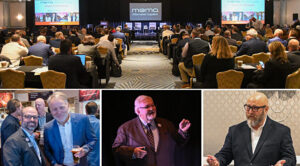Traditional auto players are not just forced to change the way they do business, they must predict the rate they need to adjust
Automotive technology disruption is no longer a theory. It’s our reality. But while the future vehicle — autonomous, connected, electric, and shared (ACES) — is currently taking shape on the market, the switch may not be as dramatic as expected.
Instead, automakers and the suppliers and technology companies that support them are being called to take a “milder” approach toward the transition.

A mild approach means that automotive companies will not only need to decipher what new legislation changes and technology breakthroughs mean for them in the future, but they must also stay atop the current demands of today’s market and how those are slowly shifting each day.
This method will help automotive businesses gradually transition to the fully automated, eco-friendly future, supporting both current and long-term success.
The 10-Year Outlook for EV Demand
Although the automotive industry has witnessed a significant amount of announcements over the last few years, autonomous, electrified vehicles will not completely dominate the market by the end of the decade.
Despite earlier industry predictions that one in four vehicles sold globally will be fully electric by 2030, most consumers will likely lean toward a hybrid for their first electric vehicle. We can also expect a majority of the public to still drive to work, home, and other destinations with relative control over their driving experience — especially in the aftermath of COVID-19.
By the end of this decade, we can expect mild-hybrid EVs to account for roughly 30 to 35 percent of global vehicle sales. For suppliers, these technologies will remain the most consistent and lucrative of the product line.
However, with recent battery advancements breaking the cost barrier and increasing pressure from governments across the globe, suppliers should still be prepared to potentially shift gears sooner. At the very least, they will begin to see a greater shift to fully electronic models by the end of 2035, when automakers will need to meet various legislative requirements that continue to serve as a major catalyst in electrification.
The 48-Volt Mild Hybrid System Is Gaining Popularity
Throughout the 2020s, the 48-volt mild-hybrid will likely be the system of choice for many automakers. More and more automakers, including Toyota and Volvo, have adopted the 48-volt system to downsize engine capacity and improve fuel efficiency.
The 48-volt mild hybrid is built with a 48-volt lithium-ion battery pack, a “mild-hybrid stat generator” that replaces the alternator and starter motor, and a low-voltage DC/DC converter.
In contrast to the standard 12-volt system, the 48-volt hybrid is powerful enough to boost engine torque and take partial control of the vehicle while powering other electronics. This added power will help auto companies navigate the addition of sophisticated features, including individual climate control, advanced entertainment, and autonomous features.
Compared to the 12-volt system, the 48-volt mild-hybrid also offers a significantly better cost-to-benefit ratio, reducing up to half of the CO2 of a full hybrid for less than a third of the cost. By reducing emissions and increasing power, the 48-volt system will help automakers meet stricter global emissions standards without sacrificing performance.
Level 2+ Autonomous Functionality Will Dominate the Market
Another source of automotive disruption is the autonomous vehicle. Over the next decade, the migration toward the fully autonomous vehicle will be made possible with the gradual introduction of interrelated safety technologies.
The number of vehicles capable of Level 1 autonomy is expected to grow from 31.4 million in 2019 to 54.2 million by 2024, representing a five-year compound annual growth rate of 11.5 percent. In addition, auto suppliers can also expect to see an increase in Level 2+ autonomous vehicles, which are expected to occupy a significant portion of the market.
L2+ technology is a mild transition from Level 2 autonomy. It offers more advanced technology than its Level 1 and 2 counterparts but at a fraction of the cost of Level 3 and 4 systems. Specifically, advanced Level 2+ systems will expand on the hands-free features of Level 2 systems, including adaptive cruise control and assisted parking, allowing drivers to enjoy a more “hands-off” experience. In low-risk situations, such as on highways, Level 2+ systems will feel fully automated.
This level of autonomous functionality has already hit the market with GM Cadillac Super Cruise and BMW’s standard semi-autonomous vehicles. In the coming years, large-volume original equipment manufacturers (OEMs), including Toyota, Ford, and Hyundai, will shift their focus toward producing vehicles with sophisticated Level 2+ functionality.
How to Prepare Your Supply Chain for “Mild” Disruptions
A once reliable and relatively predictable industry, the automotive industry is facing major supply chain shifts over the next few decades. And with a somewhat “slow” move to new, traditional auto players are not just forced to change the way they do business, but they must predict the rate at which they need to adjust.
Adjusting too slowly could quickly make them irrelevant, and transitioning too fast could cause problems with paying the bills today. Overall, these disruptions create unknown variables and force companies to make risky bets on the future of the auto industry.
The best way automotive businesses can cope is by staying plugged into emerging trends and legislative updates, investing in quality market research, and developing robust and adaptable long-term strategic plans to follow. Ultimately, the decisions you make today could determine where you land in the future.
As a strategic automotive consultant, Paul Eichenberg collaborates with automotive suppliers to develop and execute creative, innovative solutions to their industry’s complex challenges. Paul Eichenberg Strategic Consulting can be contacted here.



Comments are closed.